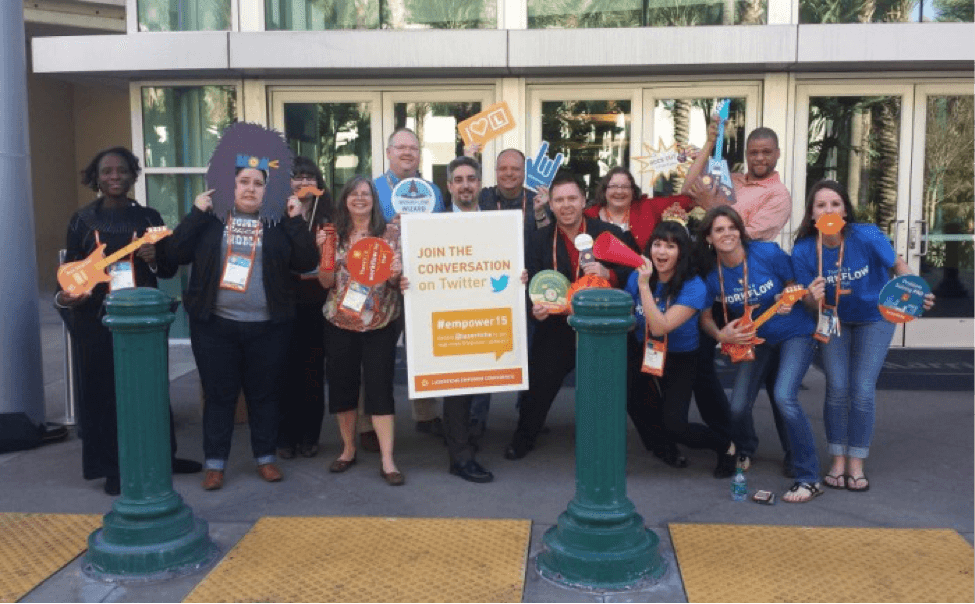If you’ve been to a marketing conference in the past 5 years, you know how powerful social engagement at B2B events can be. Conferences like MozCon and Inbound drive thousands of tweets and millions of impressions, but they are also built on a foundation of socially engaged individuals that are actively seeking interaction with other attendees.
As marketers, we know how valuable it is to engage with our peers on social networks, but outside of the marketing bubble, event-centric B2B social engagement runs into a roadblock. It seems that many event organizers will take the proactive step of providing a hashtag (if you’re stuck on finding the right hashtag for your event, check out this infographic from Twitter), but ultimately fail when it comes to nurturing real conversations within the community.
I’m sure we’ve all seen those hashtags with the same 5 people talking in circles and the 2 brands clamoring for a retweet. Unfortunately, this approach segregates social engagement from real world networking, when we should really be looking at these two activities as complimentary.
So, why do so many event organizers put social media on the sidelines?
Well, there are many excuses you’ll hear thrown around, including:
- Our audience doesn’t use social media.
- Our content is too dry or technical for anyone to talk about.
- We’re in an industry that is extremely concerned with compliance.
While there is some validity to each of these reasons, it’s important to think outside the box and find ways to overcome these issues rather than let them dictate an absolute absence from social mediums. In order to drive social engagement, and in turn event amplification, you’ll need a game plan!
Step 1: Define and Understand Your Audience
The best place to start is with the event attendee list. If you can, ask for social profile URLs (focus on Twitter handles) during the registration process. The people who are already active on social have the most potential to be your evangelists; they will ultimately be the early adopters and help drive engagement from the wider community.
As with the creation of any social epidemic, you’ll need to find your Connectors, Mavens and Salesmen – if you’re unfamiliar with these terms, check out The Tipping Point by Malcolm Gladwell. Once you have found these individuals, reach out to them and personally invite them to be a social leader at the event. Build up their egos, get them invested in the success of the event, and you’ll have an excellent foundation upon which to grow. It is important to note that this group doesn’t have to be very large; a group of 5 to 10 people will still have a much greater impact than going solo.
For more insight on scalable online community building tactics, check out this presentation: Community Development 101 or any of these fantastic resources from FeverBee.
Step 2: Drive Pre-Event Awareness
When driving pre-event awareness, you’ll need to keep in mind that you’re marketing to several groups, including: those attending, vendors exhibiting and members of your own organization. A common faux pas is to ignore marketing to your internal team and focus externally too early.
Before you begin broadcasting externally, you need to get buy in from your internal teams as early as possible. This includes everyone from the CEO down to the receptionist. There is potential for every member of your organization to be a social advocate and the more buy in you get, the easier it will be to drive conversations around the event.
To do this, you need to focus on showing the business value provided by event amplification and breaking down barriers to entry. I’ve personally found success by:
- Speaking one on one with managers to help them see the business value.
- Hosting introductory workshops covering topics like: how to set up accounts, examples of easy ways to engage and provide answers to common questions.
- Rewarding those people who make an effort to engage early.
Once you have your internal team on board and your social leaders from the community, you’re ready to start promoting externally.
Consider creating a competition using the event hashtag to win a free registration or other promotional item. This sparks engagement and will allow those early adopters to find each other before the event. If your audience isn’t already engaged on social, you’ll need to make the value of the reward high enough to get them to create an account in order to tweet.
Think about leveraging your social leaders to encourage others to participate, and providing a simple step-by-step guide to getting on board. People are much more likely to engage when asked by a peer than from a generic e-mail blast (although these still help with air cover!)
Tweet & win! Engage with us during #empower14 and you could win a limited edition I <3 Laserfiche shirt! http://t.co/bJcgFNZAMX
— Laserfiche (@laserfiche) January 15, 2014
If your event has an official PowerPoint template for presenters to use, be sure to include the hashtag on all pages and ensure presenters are aware of it. Let them know attendees will be amplifying their session on social, and they may even take the proactive step of asking attendees to engage during their presentations.
Step 3: Promotion and Onboarding at the Event
If pre-event awareness appears limited in reach, that’s okay. Just like a party, no one wants to be the first to arrive, but once a few people start, others will come out of their shells and join in. Be sure to include your social leaders in your plans and actively support conversations in the days leading up to the event. During the event you should focus on:
Awareness of social activity with live streams
If you’re not actively taking part in social conversations, it’s very easy to forget there is an online dimension to the conference. Use a tool like TweetWallPro or Enplug to visualize social activity. You’ll be amazed how many lurkers will start to pay attention and ultimately want to be part of the conversation.
It’s now easier than ever to livestream your event with tools like Google+ Hangouts, Periscope and Meerkat. Take advantage of these mediums to drive social engagement from those who are not attending the event in person. This will pay a huge role in the overall amplification of the event.
Check out this vine we used to promote awareness of our social media team:
Provide a Social Hub for Q&A and Onboarding
Just like the internal workshops discussed earlier, it’s important to break down the barriers to entry for attendees. Providing team members to help onboard your attendees will go a long way to getting them to support you, both during and after your event. Check out this tweet from an event attendee thanking us for getting them up to speed.
Thank you Simon for teaching me how to tweet last year at conference. #Empower15 @laserfiche @SPoulton
— C. Julien (@cjewel127) January 15, 2015
In addition to removing barriers, you’re also providing a human element to social media. This is something that many social media detractors value – they want the real world connection, and when we use social media as a complimentary medium, this helps alleviate this kind of sentiment.
Take a look at all of these folks the Laserfiche social team helped to get started on Twitter at our last conference:

You’ll want to be sensitive to the concerns of your audience, like compliance with industry regulations, and provide examples of what they can and cannot do. This is particularly true within Government and Financial Services industries, so be sure to read up on the best practices. (Hearsay Social provide some great resources for Financial Services in particular)
Provide Rewards
Everyone loves swag! In fact, they love it even more when it’s exclusive. By offering limited edition t-shirts, we were able to offer incentives to those who may have been on the fence about engaging. Check out this fun promotion my team did for our 2014 conference:
Tweet & win! Engage with us during #empower14 and you could win a limited edition I <3 Laserfiche shirt! http://t.co/bJcgFNZAMX — Laserfiche (@laserfiche) January 15, 2014
We only gave these out to people who were actively driving the conversation. Others started to notice this and ultimately modified their tweeting to fall more in line with the kind that we were rewarding. Beyond this, we also had spot prizes and highlighted certain individuals who went the extra mile.
Give them Something to Tweet About!
Prior to the event, you’ll need to draw up a plan for content promotion. Specifically, think about when you’ll want to post photos from the event or highlights via blog posts.
I suggest trying to get photos up immediately by posting them to your organizations Facebook page and sharing some of the highlights via twitter. Attendees love to share this type of content in real time and will help dramatically increase your reach as they share them via both Facebook and LinkedIn.
We even had one person promote our new product at Disneyland and share the snap with us via Twitter:
Using Laserfiche Mobile on Space Mountain! #empower14 @crlhntr @sambjor pic.twitter.com/i5zGb7uaXn
— Rob Ron (@RobJRon) January 15, 2014
Final Thoughts
Regardless of your goals for event social engagement, be they awareness via amplification, or targeted outreach to influencers, there is so much potential for audience engagement.
The tactics outlined in this article can easily scale, and ultimately rely on building real human to human relationships. As you’ll hear from many leaders in the social space, you can’t just do social, you must be social.
If you offer the right incentives and show value from engaging, you will quickly grow an audience within a space you may have written off. Feel free to share your own ideas for engagement with me on twitter (@SPoulton) or in the comments section below!

0 Comments on "How to Mobilize Your B2B Event Attendees on Social Media"